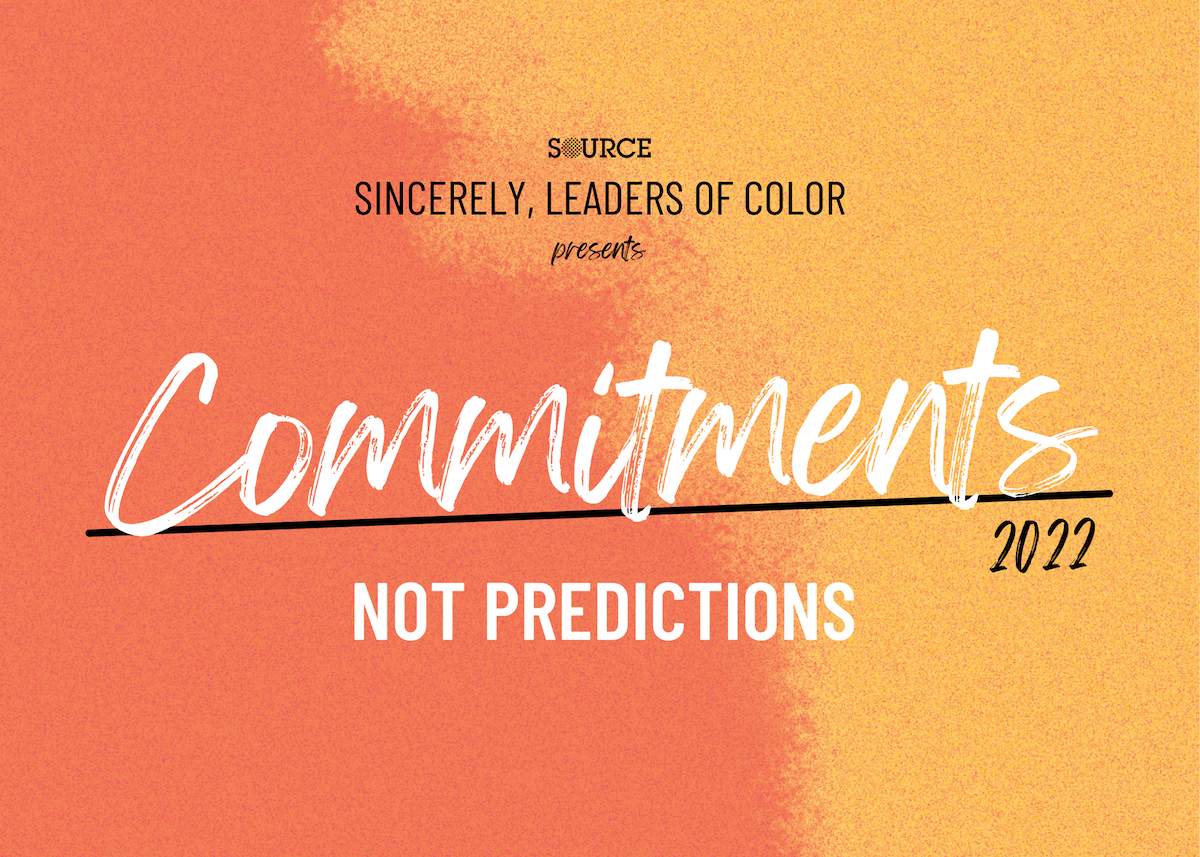Features:
Sincerely, Leaders of Color: U.S.-focused Diversity, Equity and Inclusion Strategies Don’t Scale Globally
Here’s how I’m going to tackle this issue in 2022.

Image: Big, featured typography that says “Commitments Not Predictions 2022” on top of an orange to yellow gradient in the background. Above the featured text it also says “Source” and “Sincerely, Leaders of Color presents.”
Commitments, Not Predictions: As we start 2022, Sincerely, Leaders of Color asked our fellow leaders, allies, and rebels — of all colors — to make commitments and promises for the year ahead, and how they’ll contribute to making safer, healthier newsrooms for all journalists of color. Here’s what they said. This special series is presented with support from The American Press Institute.
For years, global media discussions have been centered around United States-based organizations and examples for innovation, business models, and reporting styles often flow globally from North to South. Now, something similar is happening around DEI initiatives.
The push towards DEI initiatives in US media is a great thing, and it can help raise analog concerns in places where there hasn’t been so much reckoning. However, assuming that the same initiatives implemented to deal with discrimination in the US. are applicable elsewhere is inaccurate and short-sighted.
As it also happens with innovation, business models, and reporting styles, DEI initiatives don’t happen in a vacuum. Discrimination dynamics around the world take different forms due to historical, political, and economical circumstances. Each place has its own trajectories, both of oppression and resistance. To address these issues with a perspective developed for U.S.-based experiences and challenges will keep global newsrooms away from exploring their specific inequity problems at home.
While some aspects could even hold certain similarities across borders, copy-pasting solutions that were designed for the New York Times are unlikely to succeed in newsrooms in Buenos Aires, or Havana.
For example, the Latinx category is commonly used in the U.S to identify both migrants and descendants from the rest of the Americas. However, such classification cannot be applied in Latin American countries, where the term has no meaning as to whether a person might be considered part of a racial minority or not.
The tactics that work for a major U.S. newsroom are not necessarily the ones that would work elsewhere because journalists and leaders elsewhere are trying to solve different problems, such as: In Argentina, most people believe there is no racism even though there is little to no representation for non-European descendants in the media industry. And what’s worse, going through an American-based process provides international leaders with the placebo effect of thinking they are actually doing something to make a change.
In each society, aspects such as gender, sexual orientation, ethnicity, religion, race, national identities, and class are subject to different historically-informed arrangements. A deep understanding of these configurations is key for addressing inequity and developing solution alternatives in specific contexts.
There is an industry-wide challenge in finding ways to ensure that these relationships are taken into account when developing training, information products, and work processes for media organizations around the world. We need to make an effort to understand local realities because that is the only way in which we can catalyze change and foster a really inclusive global media industry.
I believe that news product is a discipline that could play a positive role in these matters. It is based on a profound understanding of audiences’ needs and developing news products to serve them. In that sense, Product practice can provide organizations with information about how to make information more accessible and equitable.
As News Product Alliance’s Executive Director, I am fortunate to have many types of opportunities to contribute to this mission. Some of the steps I am taking in 2022 are:
- Make sure to be intentional about including more voices from diverse backgrounds into our programming – as participants, trainers, mentors, DEI consultants, or coaches.
- As our team grows, make sure that the staffing represents the diversity of our global community.
- Offer resources to incorporate a systemic perspective with an emphasis on how dynamics of exclusion operate, as part of the news product thinking process.
This is my commitment to refine the definition of what discrimination and inclusion mean for the global journalism industry, and more specifically, for the news product discipline. Because, if we only consume one type of discourse around diversity, equity, and inclusion we won’t find the right solutions for other contexts, and leave journalists from marginalized backgrounds away and voices unheard.
Sincerely,
Feli Carrique
Executive Director at News Product Alliance
This is a guest column, solicited by P. Kim Bui and Emma Carew Grovum and edited by Emma. We want to make sure to include voices from all sorts of backgrounds and experiences. If you’re interested in guest writing, or have someone you’d love to hear from, let us know here.
Organizations
Credits
-
 Feli Carrique
Feli Carrique
Feli is an Argentinian journalist and product thinker working at the intersection of media, technology, and sustainability. In her previous role as the Innovation Director at SembraMedia, she worked with news organizations across Latin America, Spain, and the United States to promote innovation and led product design and systems development for the organization. She was also the lead analyst on the recent “Inflection Point International” report published by SembraMedia, which analyzed the innovations, challenges, and threats facing news entrepreneurs across Latin America, Africa, and Southeast Asia. In 2020 she was a chosen ICFJ Professional Fellow, and as a result, she developed Propulsorio’s Product Guide for Latin American media organizations with additional support from SembraMedia. Feli is also a Professor at Universidad Católica Argentina, where she co-created the first news product class in Latin America, and she has led workshops about news product management and journalism business models for several media-support organizations.



